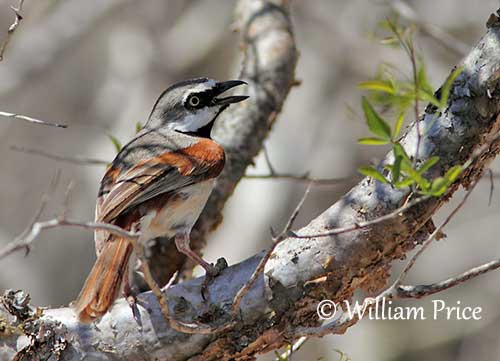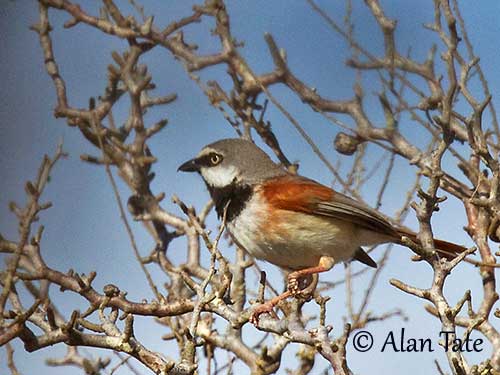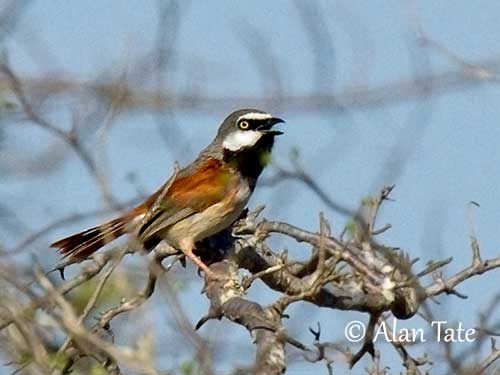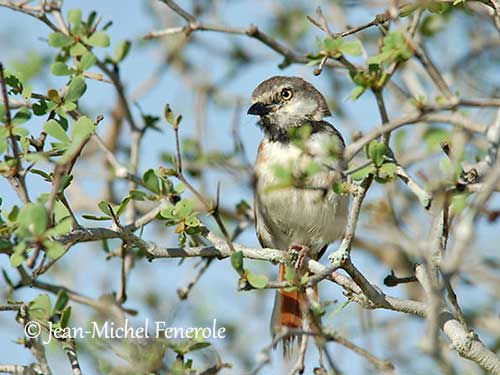
PROTECTION / THREATS / STATUS:
The Red-shouldered Vanga is threatened by clearance of shrubby habitat and grazing by goats. At some sites, the localized timber extraction is also a problem. But most areas frequented by this species are still intact because the soil is not suitable for agriculture.
The population is estimated to number 250/999 mature individuals, equating roughly to 375/1,499 individuals. The population densities are high in most of its scrubby habitats, and the numbers are suspected to be stable as long as the habitat remains intact.
But currently, the Red-shouldered Vanga is listed as Vulnerable.
Fr: Calicalic à épaulettes
Ang: Red-shouldered Vanga
All: Rotschultervanga
Esp: Vanga Hombrorrojo
Ita: Vanga spallerosse
Nd: Roodschoudervanga
Sd: rödskuldrad vanga
Photographers:
Jean Michel Fenerole
Photos d’Oiseaux du monde
William Price
PBase-tereksandpiper & Flickr William Price
Alan & Ann Tate
AA Bird Photography
Text by Nicole Bouglouan
Sources:
HANDBOOK OF THE BIRDS OF THE WORLD Vol 14 by Josep del Hoyo-Andrew Elliot-David Christie - Lynx Edicions – ISBN: 9788496553507
Birds of Madagascar: A Photographic Guide Par Pete Morris, Frank Hawkins – ISBN: 0300077556, 9780300077551- Editeur: Yale University Press, 1998
Birds of Madagascar and the Indian Ocean Islands Par Roger Safford, Adrian Skerrett, Frank Hawkins – ISBN: 1472924118, 9781472924117- Editeur: Bloomsbury Publishing, 2015
Birds of the Indian Ocean Islands Par Ian Sinclair, Olivier Langrand - ISBN: 1868729567, 9781868729562- Editeur: Struik, 2003
The Birds of Africa: Volume VIII: The Malagasy Region: Madagascar, Seychelles, Comoros, Mascarenes - Par Roger Safford, Frank Hawkins – ISBN: 1408190494, 9781408190494- Editeur: A&C Black, 2013
Creagus – Bird Families of the World – Vangas - Vanginae
THE VANGAS OF MADAGASCAR by Nick Garbutt
Field observations of the Red-shouldered Vanga: a newly described Malagasy endemic
Red-shouldered Vanga
Calicalicus rufocarpalis
Passeriformes Order – Vangidae Family
INTRODUCTION:
The Red-shouldered Vanga is endemic to Madagascar where it occurs in SW of the island. It has very restricted range and frequents dense Euphorbia scrub near sea-level.
This species was described in 1997 by Phoebe Snetsinger, a renowned bird watcher, from two specimens collected 55 years earlier in SW Madagascar.
The Red-shouldered Vanga is listed as Vulnerable due to shrub clearance and degradation by goats. However, much of its habitat is still intact because the soil is unsuitable for agriculture.

DESCRIPTION OF THE BIRD:
Biometrics:
Length: 14-15 cm
Weight: 15-17 g
The Red-shouldered Vanga is a small tit-like vanga.
The adult male has pale grey crown, nape and mantle. Lower back, rump and uppertail-coverts are brick-red. On the upperwings, flight-feathers and tertials are brown. Wing-coverts are brick-red, but greater and primary coverts are often brownish-grey distally. On the uppertail, the central pair of rectrices is brownish, whereas the others are pale brick-red.
On the underparts, chin, throat and sides of lower neck are black. Rest of underparts is whitish with pale pinkish wash on breast and flanks.
On the head, crown and nape are pale grey. We can see a white line on the forehead, extending to the upper eye. Lores and eye’s area are black. Cheeks and ear-coverts are white and contrast with the black bib.
The bill is black. The eyes are pale yellow. Legs and feet are pinkish grey.

The adult female has olive-grey-brown upperparts but the rump is pale reddish. On the tail, the rectrices have reddish outer webs. On the upperwings, lesser and median coverts are brick-red. She has not black on head.
On the underparts, chin and throat are whitish (not black) and rest of underparts is washed buff, becoming whitish on belly and undertail-coverts. The bare parts are like in male.

The juvenile has buff upperparts streaked blackish, including on the head. The underparts are white. The eyes are dark.
RANGE:
The Red-shouldered Vanga can be seen in SW Madagascar, in Toliara area and Mahafaly Plateau S to Lintsa.
HABITAT:
The Red-shouldered Vanga frequents dense scrubs with Euphorbia on limestone, between sea-level and 100 metres of elevation.
CALLS AND SONGS: SOUNDS BY XENO-CANTO
The Red-shouldered Vanga’s contact call is a loud, slightly whistling “ksisisisisusususu” given at rapid, rolling cadence. The alarm call is a “karr-tskkk” that drops into a low rattle, but it may vary to a rolling “kwoiroikk” ending again is a slight rattle.
The song of the male is a loud “tyuh-tee” or “pu-teer” with louder, more whistled second note. This song is often followed by a contact call by the female, given in duet-like fashion.

BEHAVIOUR IN THE WILD:
The Red-shouldered Vanga feeds on small invertebrates, mainly insects and small caterpillars.
It forages by gleaning and sally-gleaning in dense low vegetation, plucking small prey items from leaves and branches. It is often seen in small groups.
From some observations of a feeding male, the bird frequently tries to flush potential prey by flicking its wings open once or twice. This behaviour is usually followed by attempted sally-gleans. The prey is held in the feet and dismembered with the bill.
The breeding behaviour of the Red-shouldered Vanga is poorly known. We can suggest that the bright face pattern and the red-brick shoulders are enhanced during the displays. The male is more vocal during the breeding season.
The Red-shouldered Vanga is probably sedentary. In flight, the tail appears relatively rufous.

REPRODUCTION OF THIS SPECIES:
The breeding season of most vanga species occurs during the southern summer, between September/October and December/January.
The nest is cup-shaped and made with woven dried grasses. The cup is probably lined with softer materials. There are some pieces of lichens on the outer part, held together with spider webs. This small structure is placed in a fork in small tree, between two or three small branches.
Information on nesting behaviour is lacking, but fledglings have been recorded in January.
The young bird has whitish plumage with darker upperparts. Head, nape, mantle and shoulders are streaked brown. Wing-coverts and flight feathers are brown. The short tail shows some rufous tinge. The underparts are whitish. The eyes are dark, not pale yellow.
